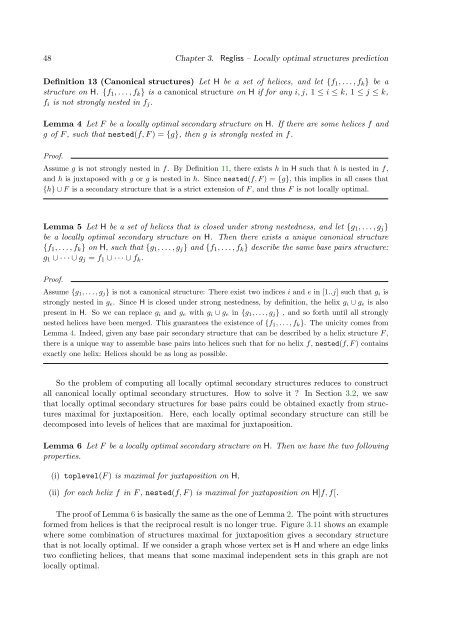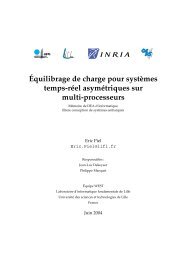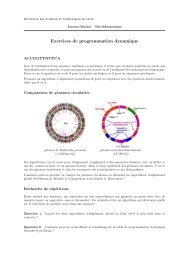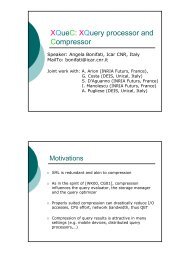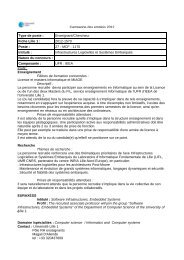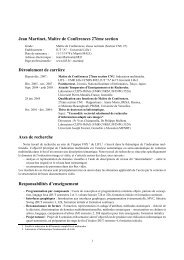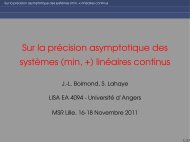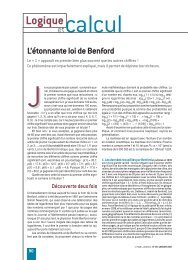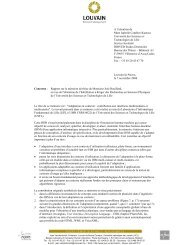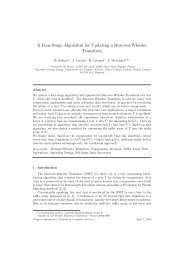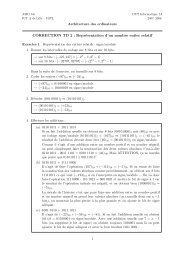Algorithmes de prediction et de recherche de multi-structures d'ARN
Algorithmes de prediction et de recherche de multi-structures d'ARN
Algorithmes de prediction et de recherche de multi-structures d'ARN
Create successful ePaper yourself
Turn your PDF publications into a flip-book with our unique Google optimized e-Paper software.
48 Chapter 3. Regliss – Locally optimal <strong>structures</strong> <strong>prediction</strong><br />
Definition 13 (Canonical <strong>structures</strong>) L<strong>et</strong> H be a s<strong>et</strong> of helices, and l<strong>et</strong> {f1, . . . , fk} be a<br />
structure on H. {f1, . . . , fk} is a canonical structure on H if for any i, j, 1 ≤ i ≤ k, 1 ≤ j ≤ k,<br />
fi is not strongly nested in fj.<br />
Lemma 4 L<strong>et</strong> F be a locally optimal secondary structure on H. If there are some helices f and<br />
g of F , such that nested(f, F ) = {g}, then g is strongly nested in f.<br />
Proof.<br />
Assume g is not strongly nested in f. By Definition 11, there exists h in H such that h is nested in f,<br />
and h is juxtaposed with g or g is nested in h. Since nested(f, F ) = {g}, this implies in all cases that<br />
{h} ∪ F is a secondary structure that is a strict extension of F , and thus F is not locally optimal.<br />
Lemma 5 L<strong>et</strong> H be a s<strong>et</strong> of helices that is closed un<strong>de</strong>r strong nestedness, and l<strong>et</strong> {g1, . . . , gj}<br />
be a locally optimal secondary structure on H. Then there exists a unique canonical structure<br />
{f1, . . . , fk} on H, such that {g1, . . . , gj} and {f1, . . . , fk} <strong>de</strong>scribe the same base pairs structure:<br />
g1 ∪ · · · ∪ gj = f1 ∪ · · · ∪ fk.<br />
Proof.<br />
Assume {g1, . . . , gj} is not a canonical structure: There exist two indices i and e in [1..j] such that gi is<br />
strongly nested in ge. Since H is closed un<strong>de</strong>r strong nestedness, by <strong>de</strong>finition, the helix gi ∪ ge is also<br />
present in H. So we can replace gi and ge with gi ∪ ge in {g1, . . . , gj} , and so forth until all strongly<br />
nested helices have been merged. This guarantees the existence of {f1, . . . , fk}. The unicity comes from<br />
Lemma 4. In<strong>de</strong>ed, given any base pair secondary structure that can be <strong>de</strong>scribed by a helix structure F ,<br />
there is a unique way to assemble base pairs into helices such that for no helix f, nested(f, F ) contains<br />
exactly one helix: Helices should be as long as possible.<br />
So the problem of computing all locally optimal secondary <strong>structures</strong> reduces to construct<br />
all canonical locally optimal secondary <strong>structures</strong>. How to solve it ? In Section 3.2, we saw<br />
that locally optimal secondary <strong>structures</strong> for base pairs could be obtained exactly from <strong>structures</strong><br />
maximal for juxtaposition. Here, each locally optimal secondary structure can still be<br />
<strong>de</strong>composed into levels of helices that are maximal for juxtaposition.<br />
Lemma 6 L<strong>et</strong> F be a locally optimal secondary structure on H. Then we have the two following<br />
properties.<br />
(i) toplevel(F ) is maximal for juxtaposition on H,<br />
(ii) for each helix f in F , nested(f, F ) is maximal for juxtaposition on H]f, f[.<br />
The proof of Lemma 6 is basically the same as the one of Lemma 2. The point with <strong>structures</strong><br />
formed from helices is that the reciprocal result is no longer true. Figure 3.11 shows an example<br />
where some combination of <strong>structures</strong> maximal for juxtaposition gives a secondary structure<br />
that is not locally optimal. If we consi<strong>de</strong>r a graph whose vertex s<strong>et</strong> is H and where an edge links<br />
two conflicting helices, that means that some maximal in<strong>de</strong>pen<strong>de</strong>nt s<strong>et</strong>s in this graph are not<br />
locally optimal.


